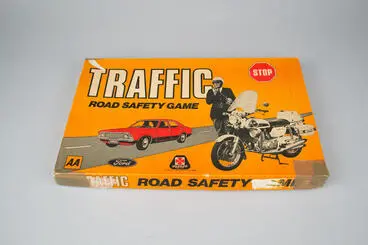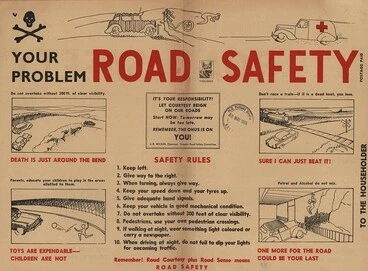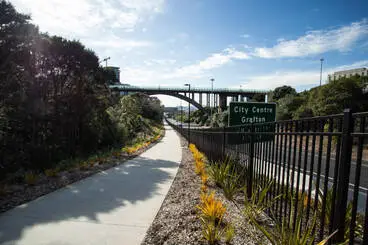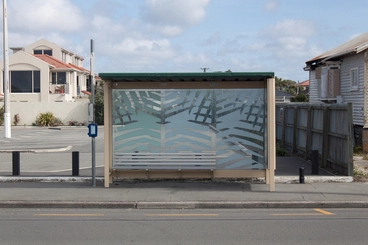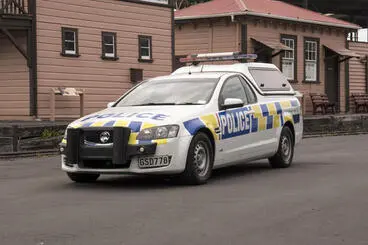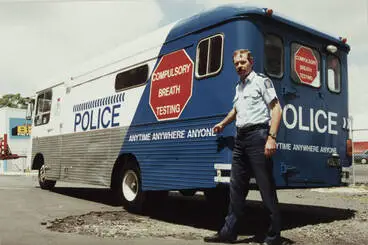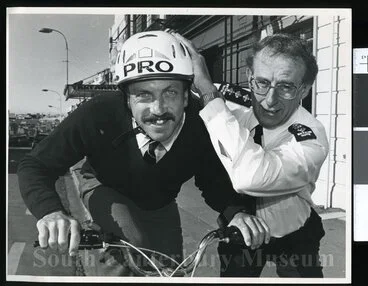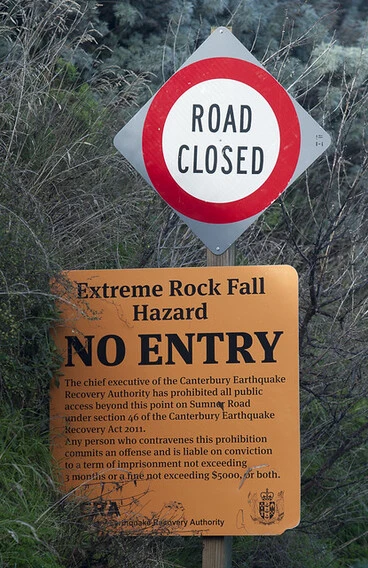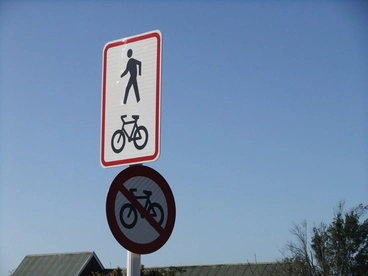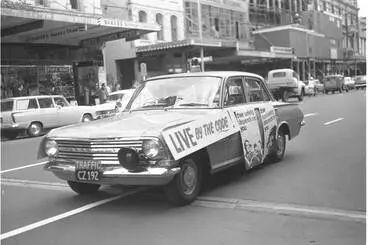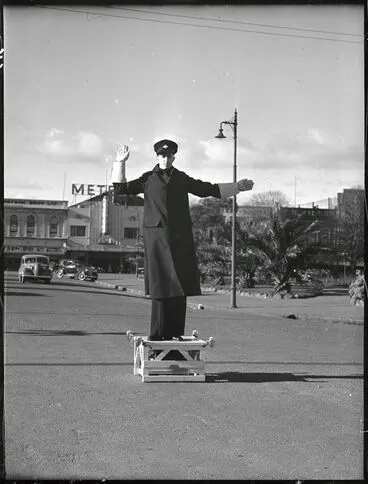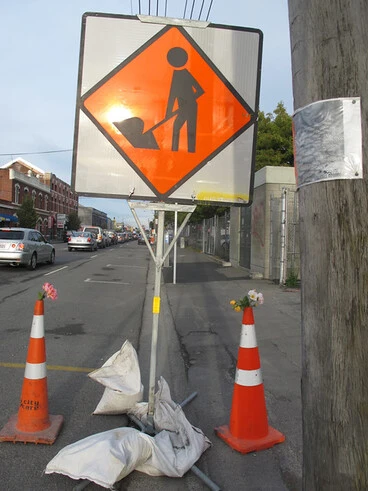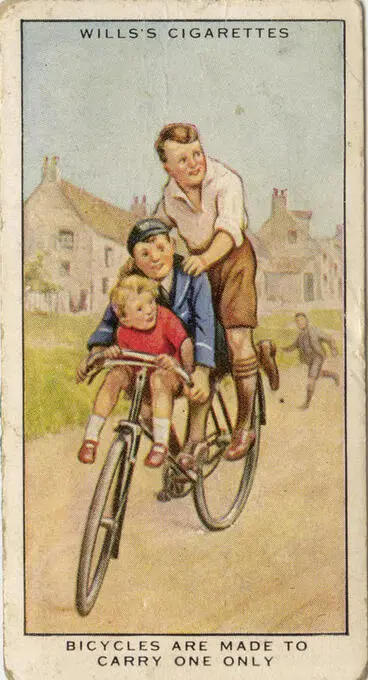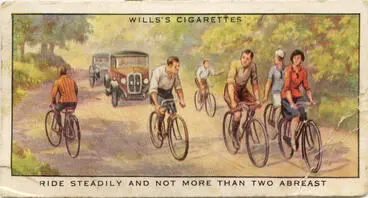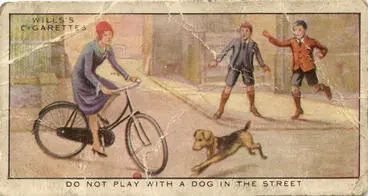Road Safety
A DigitalNZ Story by National Library Services to Schools
This story covers road safety from the point of view of drivers, pedestrians, and passengers. It also includes items like seatbelts, helmets, and signs that keep us safe on the road.
Look to the left, then to the right, then to the left again before crossing the road.
Alexander Turnbull Library
Roads are busy places with lots of traffic moving in different directions and speeds. This is why there are traffic police, road signs and road rules to make sure that drivers drive safely, and pedestrians are safe while walking and crossing roads.
This story on road safety contains the following:
- Safety on the road
- Road safety for drivers
- Road safety for pedestrians
- Safety on the bike
- Auto safety
- Safety in the car
- Safety in the bus
- Keeping us safe on the road
- New Zealand Police
- Helmets
- Safety belts and booster seats
- Road signs and road codes
- Quick facts
- Glossary
- Bibliography
- Supporting resources
- Teaching and learning resources
- A gallery of posters on road safety
SAFETY ON THE ROAD
DRIVER SAFETY
To keep drivers, pedestrians, and vehicles safe on the road the New Zealand Transport Authority (NZTA) issues different driver licences for different vehicles like cars, trucks, motorcycles, and tow trucks.
There are also many rules for driving a vehicle in New Zealand
- You must be 16 years old to get a learner’s licence.
- Drivers must know the Road Code of New Zealand to practice safe driving and observe traffic rules.
- We drive on the left side of the road.
- All drivers need to pass a theory and practical test, prove they are medically fit and have good eyesight to drive.
- Drivers must have a valid New Zealand driver’s license when driving at all times.
- Vehicles in New Zealand must have a Warrant of Fitness (WoF) sticker visible. This sticker means the vehicle has been checked and is safe to drive on the road.
For more information about driving in New Zealand visit the New Zealand Transport Agency
Drink driving blitz
Manatū Taonga, the Ministry for Culture and Heritage
Road Safety Rules from 1955
Archives New Zealand Te Rua Mahara o te Kāwanatanga
PEDESTRIAN SAFETY
Walking is a good form of exercise, so it's important to keep in mind safety tips if you need to cross the road.
- Walk on the footpath and away from the road.
- Never run onto a road.
- Where possible cross the road at a pedestrian crossing, traffic lights or a courtesy crossing.
- If there is no pedestrian crossing, then stop at the kerb, listen and look to the left, the right and then again to the left for oncoming traffic. If there is none quickly cross the road.
- Be patient if there is lots of traffic. Cross the road only when it is safe. Walk straight across the road. Keep an eye out for vehicles turning or coming out of a driveway.
- Avoid crossing a road from between parked cars, drivers may not be able to see you.
- Make sure you can be seen while crossing a street.
For more information, visit How to stay safe when walking from the New Zealand Transport Agency (NZTA).
Walking school bus, 2007
Manatū Taonga, the Ministry for Culture and Heritage
Kids in Queen Street
Auckland War Memorial Museum Tāmaki Paenga Hira
CYCLIST SAFETY
A sunny day is perfect to get on your bike and go for a ride. Before you set out though, find out how to stay safe on your bike.
- It is compulsory to wear a helmet if you are cycling in New Zealand. Make sure that it fits your head well.
- Ride on the footpath in a straight line. Riding on the road is for children over the age of 11. Read more about this law from The official New Zealand code for cyclists.
- Ride a bike that is the right size for you. Your feet should reach the ground when seated.
- Do a bike safety check – are front and back breaks working well? Are the seat, handlebars, and wheels tight? Do the tires have enough air and is the cycle chain well oiled?
- Wear comfortable footwear and clothes when riding. Avoid clothing that can get caught in the cycle wheels or chain.
- Keep both hands on the handlebar when riding.
- Watch out for road hazards like potholes, puddles and pedestrians.
- Map your route so that you are familiar with where you are going.
- Ride during the daytime. Avoid riding in the dark.
For more information visit Biking to school safely and Cycle safety from the New Zealand Transport Agency.
Cycle safety film
Manatū Taonga, the Ministry for Culture and Heritage
Traffic training, Karori School
Alexander Turnbull Library
Children preparing to take part in "Bike for Fun."
Alexander Turnbull Library
BMX bikes and 10-speeds
Manatū Taonga, the Ministry for Culture and Heritage
Grafton Gully Cycleway, Auckland Central, 2016
Auckland Libraries
CAR SAFETY
Cars are a quick and comfortable way to get to school, practice, or a friend's house. Sitting in a car comes with the responsibility though.
Here are some New Zealand Car Seat Laws from The New Zealand Automobile Associaton (AA) :
- Any child in New Zealand, up until their 7th birthday, must be in an appropriate child restraint.
- When a child is 7 years old (between their 7th and 8th birthdays), they must be in an appropriate child restraint if there is one available in the vehicle.
- Once a child has reached 8 years old, they are no longer required by law to use a child restraint.
This means a seatbelt is compulsory for children over the age of 8.
Here are some other safety measures to keep in mind when sitting in a car:
- Fasten your seatbelt as soon as you get into a car. Keep it on even if it is a short drive. Check with an adult if you need to sit in the front seat or the backseat of the car.
- Check that the car door nearest to you is shut securely. Keep the door shut while the car is moving.
- Open the car door only when the car has stopped moving and it is safe to leave the car. When opening a car door, make sure that there are no obstructions near the car door.
- Let the driver know if you want to open or shut a car window when the car is moving.
- Keep your arms and head inside the car at all times.
- Keep litter in the car and dispose of it when you can into a trash bin.
- Help the driver to concentrate on the road by being calm and quiet in the car.
- Avoid changing seats when the car is moving. Wait for the driver to stop the car before changing seats.
Road safety; seat-belt slogan competition; joint winning entries held by Janelle Foster.
Upper Hutt City Library
Child restraints become compulsory; Plunket rental offerings
Upper Hutt City Library
BUS SAFETY
Sometimes we need to use the school bus or the public bus service to take us to school or other places. While a bus ride can be a lot of fun, we also need to think about our safety.
The New Zealand Transport Authority has lots of safety tips for when waiting for the bus, getting on the bus, riding on the bus and getting off the bus.
- Wait at the nominated bus stop area.
- Keep well away from the road edge.
- Form a single line.
- Make sure the bus has stopped before you try to get on.
- Quickly choose your seat and sit down.
- Put your bag on your lap or under your seat keep the bus aisle clear.
- Stay in your seat until the bus has stopped.
- Follow what the bus driver or bus warden tells you to do.
- Get off the bus carefully, without pushing.
For more information visit School bus safety tips from the New Zealand Transport Authority.
School bus sign
Manatū Taonga, the Ministry for Culture and Heritage
School bus, 1920s
Manatū Taonga, the Ministry for Culture and Heritage
Bus stop on Marine Parade, New Brighton
Christchurch City Libraries
KEEPING US SAFE ON THE ROAD
Now let's look at why we have traffic police and how helmets, safety belts, road signs, road rules, and road codes help us to stay safe on the road.
NEW ZEALAND POLICE
New Zealand Police have an important part to play in making roads safe. They make sure that:
- traffic laws are followed
- speed limits are obeyed
- road safety education and good driving practices are promoted
- road safety measures and procedures are up-to-date
• road accidents are responded to and investigated. This is to get help for the injured and to identify the cause of the crash.
Policing technology: laser speed camera, 2009
Manatū Taonga, the Ministry for Culture and Heritage
'Booze bus', Manukau City Centre, 1996
Auckland Libraries
HELMETS
A helmet will help protect your face and head if you fall onto the road or footpath in an accident. It is compulsory to wear a helmet when riding a bike in New Zealand. Make sure your helmet:
- is in good condition
- has passed safety standards
- is the correct size
- is worn correctly.
Read more about how to check a helmet's condition and how to fit it correctly from Auckland Transport.
Mark Hervey and John Hume demostrating cycle safety
South Canterbury Museum
Saved by a helmet
Manatū Taonga, the Ministry for Culture and Heritage
Harcourt Park; children's duathlon; Oliver and Kimberley Evison register.
Upper Hutt City Library
SAFETY BELTS AND BOOSTER SEATS
A safety belt or a booster seat helps protect you from getting injured in an accident. Make sure the safety belt:
- fits well
- is in good condition.
- is fastened as soon as you get into the car and is unfastened only when it’s time to leave the car.
For more on seat belts and booster seats visit the New Zealand Transport Agency.
Unidentified man in the car, with his safety belt on, Wellington
Alexander Turnbull Library
ROAD SIGNS AND ROAD CODES
Most of the road signs used in New Zealand are similar to traffic signs used around the world.
There are 3 main types of road signs:
- Compulsory signs — tell you can or can not do such as no turning left or parking for buses only.
- Warning signs — alert you to dangers ahead such as a slippery surface or roadworks.
- Information signs — are useful signs that show state highway numbers, and direction and distances to the nearest towns.
Road codes are for car drivers, truck drivers, motorcyclists or cyclists and help educate drivers about road signs, conditions, rules, speed limits, hazards, and conditions.
20130618_7675_1D3-200 No Entry
eqnz.chch.2010
Sign, pedestrian and bicycle
Christchurch City Libraries
BeckerFraserPhotos April 2012 photograph 348
UC QuakeStudies
QUICK FACTS
- Road Safety Week is an annual event run by Brake New Zealand to draw attention to and promote road safety in towns, cities, communities, organisations, and schools.
- In 2008 a number of road accidents and deaths were caused by text messaging or talking on cell phones while driving.
- The number of vehicles on the road is expected to double by 2030 around the world.
- Unlike New Zealand, many nations do not have laws that make it compulsory to wear helmets while riding motorcycles and bicycles.
- Driver’s licences became compulsory in New Zealand in 1925.
- The first speed detectors came into use in New Zealand by 1949. They are used to identify speeding drivers from a distance. A traffic officer can then radio ahead another traffic officer further down the road, who can then stop the car as it comes near.
- School patrols began in 1938. You will see them at the beginning and end of a school day. They are run by school staff and children to help students cross busy roads near the school.
- The first crosswalk was installed in Slough, England in 1951. It became known as a ‘zebra crossing’ because of its stripes.
- Airbags and seat belts help protect passengers in a crash. They inflate like a balloon seconds after impact and act as a cushion to protect people in a car from hitting against the steering wheel or a window.
- Traffic signals or traffic lights at road intersections and pedestrian crossings are used to control the flow of traffic. A red light means stop, a green light means you can go, and the amber or yellow light means the lights are about to turn red, so you should stop if it’s safe to do so.
GLOSSARY
Definitions below have been taken from the Oxford Learner's Dictionary.
airbags — a safety device in a car that fills with air if there is an accident, to protect the people in the car.
compulsory — that must be done because of a law or a rule.
concentrate — to give all your attention to something and not think about anything else.
distractions — a thing that takes your attention away from what you are doing or thinking about.
investigated — to carefully examine the facts of a situation, an event, a crime, etc. to find out the truth about it or how it happened.
license — to give somebody official permission to do, own, or use something.
nominated — to formally suggest that somebody/something should be chosen for an important role, prize, position, etc.
obstructions — the fact of trying to prevent something/somebody from making progress.
pedestrians — a person walking in the street and not travelling in a vehicle.
responded — to do something as a reaction to something that somebody has said or done.
valid — that is legally or officially acceptable
BIBLIOGRAPHY
Use our lending service to order these books and other related topics associated with fire safety.
PICTURE BOOKS
Perky by the Roadside by Michelle Osment, 2006 (primary).
Pukeko by Marie Langley, 2006 (primary).
The Queue that Grew by Janet Slater Bottin, 2007 (primary).
FICTION
The Hodgeheg by Dick King-Smith, 2010 (primary).
How to Cross the Road and Not Turn Into a Pizza by Anne Fine, 2002 (primary).
NON-FICTION
Bike Safety: A Crash Course by Lisa J. Amstutz, 2014 (primary).
Kapai’s Keepsafe Children’s Road Code by Uncle Anzac, 1999 (primary).
Staying Safe in the Car by Joanne Mattern, 2007 (primary).
Staying Safe on the School Bus by Lucia Raatma, 2012 (primary).
We Learn About Road Safety by Constance Omawumi Kola-Lawal, 2013 (primary).
Car decorated with road safety posters, 1965
Auckland Libraries
Winter, Mark, 1958- :Road signs. 11 April 2014
Alexander Turnbull Library
Traffic Officer
Palmerston North City Library
SUPPORTING RESOURCES
Some of the following links are not from New Zealand websites. However, but the rules and guidance can still be universally applied for children learning about road safety.
ROAD SAFETY FOR DRIVERS
Driving and road safety — covers rules about driving, including speed limits, how to be safe in your vehicle and how to report a bad driver.
Driving safely — key factors involved in safer driving.
Four ways to be a safer driver — from the Automobile Association of New Zealand come some simple ways every driver can help to make the roads safer.
Road safety — from Auckland Transport in partnership with other national groups to improve road safety measures to keep people safe.
ROAD SAFETY FOR PEDESTRIANS
Child pedestrian safety — a parent’s guide from Christchurch City Council.
Helping Hands – Road Safety Activity Book — has two books. One book is for parents to help teach their child to keep safe on the road. The other book provides fun road safety activities for children to enjoy while they learn.
The Road safety bear— is an interactive New Zealand site that teaches children about keeping safe around roads and traffic.
Road safety tips to teach your children — explains key safety measures needed when crossing the road.
Safety 4 kids — covers bus travel, walking in car parks, pedestrian crossings, crossing the road and riding your bike.
BIKE SAFETY
Bike — top tips and infographics on rules for riding a bike and wheeled sports.
Bike safety — why it is important choosing the right bike, wearing a helmet and where it is safe to ride a bike?
Cycle safety— the New Zealand Transport Authority has simple tips on sharing the road, safety tips for cycling on roads, advice on buying a bike, and helmet safety.
Biking to school safely — teaches things to consider like riding a bike, helmets, planning a route, sharing the road and weather factors for riding.
Kids and bicycle safety — has safety checks for bikes, rules for riding on the road and on the sidewalk.
New Zealand code for cyclists online — a user-friendly guide to New Zealand’s traffic law and safe driving practices.
Teaching children bicycle safety — has tips for bike safety, rules of the road and the importance of wearing helmets.
VEHICLE SAFETY (CAR AND BUS)
Child safety in cars — Auckland Transport has guidelines on driver responsibility for children and how to install a car seat.
A convoy of road safety recordings — is an online collection from Ngā Taonga of road safety commercials for the promotion of road safety from the 1950s.
Requirements for using child restraints in New Zealand — has clear guidelines on child restrains needed according to age.
Safety precautions for kids in cars — covers safety seats and safety belts.
School bus safety rules — has information about getting on the bus safely, rules for riding the bus and rules for leaving the bus.
Staying safe in the car and on the bus — rules for car and bus safety.
TEACHING AND LEARNING RESOURCES
Feet First — learning experiences for teacher-directed inquiry around the context of walking as active travel.
Teacher resources — to support road safety practices, and safety tips for students at primary and secondary levels.
Road Map: describes road safety education in schools and outlines available resources.
Road Safe (for years 4-6) — from New Zealand Police is a series of resources to help students participate in activities that make them aware of traffic environments and responsible and considerate road users.
6th UN Global Road Safety Week— global events, news updates and toolkit and resources to get involved in Road Safety.
'Speed' is the theme for Road Safety Week 2021 — explore what this means and why it has been selected in Aotearoa New Zealand.
Teaching road safety: a guide for educators — guidelines, lessons, ideas, and activities on teaching road safety for children and young people from ages 2 to 18.
Traffic safety campaign
Alexander Turnbull Library
School crossing children's parade 1993 in Main Street, with 'Ronald McDonald'.
Upper Hutt City Library
Road cones
eqnz.chch.2010
A GALLERY OF IMAGES AND POSTERS ON ROAD SAFETY
Mitchell, Leonard Cornwall Mitchell, 1901-1971: These people are careful and courteous [1938?]
Alexander Turnbull Library
[New Zealand. Transport Department?]: [Half-sheet of road safety cinderellas. ca 1938]
Alexander Turnbull Library
Poster, 'Watch out - kids are about'
Museum of New Zealand Te Papa Tongarewa
Street safety for children
Manatū Taonga, the Ministry for Culture and Heritage
This story was curated and compiled by Te Puna Mātauranga o Aotearoa | National Library of New Zealand, Services to Schools staff, October 2020.
